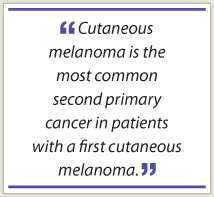Patients with a previously diagnosed cancer have an increased risk of developing cutaneous melanoma, with the highest risk among patients who have had a prior diagnosis of melanoma, according to a report published in the Archives of Dermatology.1
Key Findings
Using Surveillance, Epidemiology, and End Results (SEER) data, researchers from the Case Western University School of Medicine compared a cohort of patients with cutaneous melanoma as a first primary cancer with a cohort of patients diagnosed with cutaneous melanoma after a previous cancer and calculated the relative risk (RR) of developing a primary cutaneous melanoma following a previous cancer. The greatest number of melanomas developed among patients with a previous melanoma diagnosis, a finding consistent with other studies, the investigators noted.
The cohort of patients with cutaneous melanoma as a first primary cancer was larger—70,819 patients, compared to 6,353 patients with cutaneous melanoma following a previous cancer—and had a younger median age at the time of melanoma diagnosis—54 years compared to 70 years. Patients in the cohort diagnosed with cutaneous melanoma after a previous cancer were more likely to be male (67.1% vs 54.2%).
“The finding that a greater number of patients in the second cohort were older and male compared with the first cohort is likely because many of the observed melanoma cases in the second cohort followed prostate cancer. In addition, men are at increased risk of developing cancers in general compared with women, perhaps because of certain occupational exposures and social risk factors such as drinking and smoking,” the investigators stated. “The greater age at melanoma diagnosis in the second cohort may also explain the increased rate of lentigo maligna melanoma, which usually occurs on the head and neck regions of older individuals with chronic sun-damaged skin.”
Continued Surveillance Needed
 Patients younger than 45 years at first cancer diagnosis had a significantly higher risk of cutaneous melanoma following an earlier cutaneous melanoma (RR = 11.89), other nonepithelial skin cancer (RR = 2.81), Kaposi sarcoma (RR = 3.26), female breast cancer (RR = 1.38), and lymphoma (RR = 1.79). Patients 45 years or older at first cancer diagnosis had a significantly higher risk of cutaneous melanoma following prior cutaneous melanoma (RR = 8.36), other nonepithelial skin cancer (RR = 2.00), ocular melanoma (RR = 5.34), female breast cancer (RR = 1.12), prostate cancer (RR = 1.08), thyroid cancer (RR = 1.40), lymphoma (RR = 1.34), and leukemia (RR = 1.79).
Patients younger than 45 years at first cancer diagnosis had a significantly higher risk of cutaneous melanoma following an earlier cutaneous melanoma (RR = 11.89), other nonepithelial skin cancer (RR = 2.81), Kaposi sarcoma (RR = 3.26), female breast cancer (RR = 1.38), and lymphoma (RR = 1.79). Patients 45 years or older at first cancer diagnosis had a significantly higher risk of cutaneous melanoma following prior cutaneous melanoma (RR = 8.36), other nonepithelial skin cancer (RR = 2.00), ocular melanoma (RR = 5.34), female breast cancer (RR = 1.12), prostate cancer (RR = 1.08), thyroid cancer (RR = 1.40), lymphoma (RR = 1.34), and leukemia (RR = 1.79).
“Characteristics associated with better survival in both cohorts included female sex, age younger than 45 years at melanoma diagnosis, being married, being white vs black, decreasing Breslow depth, lack of tumor ulceration, no nodal involvement, and absence of metastases,” the researchers reported.
“Given that cutaneous melanoma is the most common second primary cancer in patients with a first cutaneous melanoma (a risk that remains elevated for over 15 years), our results suggest the need for continued skin surveillance in melanoma survivors,” they concluded. ■
Reference
1. Yang GB, Barnholtz-Sloan JS, Chen Y, et al: Risk and survival of cutaneous melanoma diagnosed subsequent to a previous cancer. Arch Dermatol 147:1395-1402, 2011.

